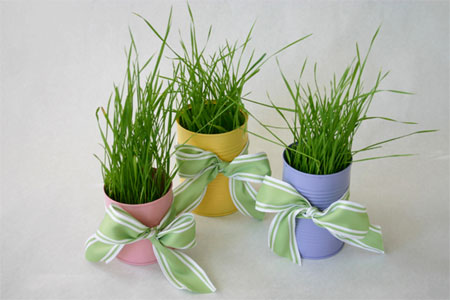Grow your own wheatgrass in colourful, recycled containers
Recycle aluminium cans into colourful containers for growing wheatgrass.
Wheatgrass is fast becoming one of the most widely used supplemental health foods. It contains chlorophyll (nature's most health promoting nutrient), 20 amino acids, several hundred different enzymes not found in other foods, as many as 90 out of 102 possible minerals, vitamins and other important nutrients. It is perfect for dieters, athletes, people on the go, who want to maintain a healthy immune system, or anyone who wants to feel great.
Spray the empty cans with Rust-Oleum 2X spray paint - satin finish - in your choice of colours. The tins here look absolutely gorgeous in pastel shades, but you can just as easily spray them in glossy bold colours. You will find the full range of Rust-Oleum spray colours at your local Builders Warehouse.
Boost your health and vitality daily with a constant supply of fresh wheatgrass. A wheatgrass kit contains all the ingredients you’ll need to grow your own nutritious wheatgrass and easy and uncomplicated growing instructions will guide you in sprouting and planting your own tray.
Instead of planting the wheatgrass in trays, use the bottoms of plastic bottles and place these inside your empty tin cans.
Tips for growing wheatgrass
-
Fill the tray with an organic compost mixture.
-
Place 150-200 grams of the wheatgrass seed into a jar, fill with water, and soak overnight.
-
Drain off the water and plant the seed by gently spreading it evenly over the top of the soil, not buried in the soil.
-
Water the tray of wheatgrass seed thoroughly, making sure not to disturb the seed.
-
Get some newspaper. Take 6 to 8 pages of newspaper and completely cover the tray so that as little light as possible reaches the seed. Soak the newspaper completely with the watering can. This will help the seeds to sprout.
-
For the next 2 to 3 days, keep newspaper wet! Important! If newspaper dries out, the root hairs of the wheat will dry out and the grass will not come up well. A piece of plastic can be laid over the newspaper to keep in from drying out. On the second day take the newspaper off and water the grass and then place the newspaper back on for one more day.
-
When the grass is one to 5 to 6cm tall, remove the newspaper and expose to indirect light. If it is completely hot outside, put the tray in the shade. If you grow it inside the house, drain over your sink, and then put grass near a window.
-
Once the wheatgrass are set out in the light, they need to be watered every day. If you have problems with mould, then add 1 tablespoon of organic seaweed fertiliser to a litre of water and use that to water the grass.
-
Begin to harvest the grass when it is 15 to 20cm tall. You can only harvest when you are going to juice at that time or you can harvest the whole tray. If you harvest the whole tray put it into a plastic bag and store in your refrigerator.
- Each tin harvests approximately 100 grams of juice. 30 grams of wheatgrass a day to begin with is ideal, working up to 100 grams. Wheatgrass juice should be taken on an empty stomach, several times a day.
images via bee in our bonnet
Wheatgrass is the young grass stage of grain plants, taken just after sprouting. It has been described as " Quite possibly the closest thing to the fountain of youth man has ever conjured up ". [Wheatgrass for Life]
The action of amino acids on cells in the process of self-renewal rejuvenates and prolongs life. Wheatgrass contains the following amino acids:
-
Absenisic
-
Lysine - anti-ageing
-
Leucine - energy and nerve stimulation
-
Tryptophane - skin and hair growth
-
Phenylalanine
-
Theronine - digestion and assimilation
-
Valine - brain/muscle co-ordination
-
Methionine
-
Alanine - blood builder
-
Arginine
-
Glumatic acid - mental alertness
-
Aspartic acid - energy
-
Glycine - energy
-
Proline - glumatic acid absorption
-
Serine - brain stimulation
-
Isoleucine - growth in infants
(Dr. Ann Wigmore, 1989)


